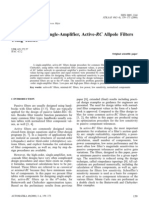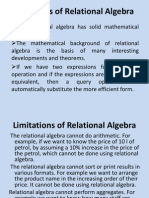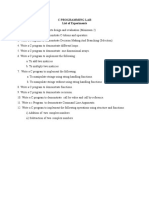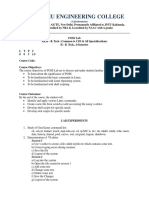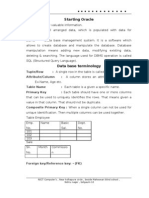0 ratings0% found this document useful (0 votes)
3 viewsQ Optimizer
Q Optimizer
Uploaded by
Ravi Varma D V SThe document discusses query optimization techniques used by a query optimizer. It describes steps like converting queries to blocks, translating to relational algebra, applying equivalences, estimating costs and result sizes. Estimating reduction factors is important for cardinality estimation.
Copyright:
© All Rights Reserved
Available Formats
Download as PDF, TXT or read online from Scribd
Q Optimizer
Q Optimizer
Uploaded by
Ravi Varma D V S0 ratings0% found this document useful (0 votes)
3 views15 pagesThe document discusses query optimization techniques used by a query optimizer. It describes steps like converting queries to blocks, translating to relational algebra, applying equivalences, estimating costs and result sizes. Estimating reduction factors is important for cardinality estimation.
Original Description:
kiit m.tech
Copyright
© © All Rights Reserved
Available Formats
PDF, TXT or read online from Scribd
Share this document
Did you find this document useful?
Is this content inappropriate?
The document discusses query optimization techniques used by a query optimizer. It describes steps like converting queries to blocks, translating to relational algebra, applying equivalences, estimating costs and result sizes. Estimating reduction factors is important for cardinality estimation.
Copyright:
© All Rights Reserved
Available Formats
Download as PDF, TXT or read online from Scribd
Download as pdf or txt
0 ratings0% found this document useful (0 votes)
3 views15 pagesQ Optimizer
Q Optimizer
Uploaded by
Ravi Varma D V SThe document discusses query optimization techniques used by a query optimizer. It describes steps like converting queries to blocks, translating to relational algebra, applying equivalences, estimating costs and result sizes. Estimating reduction factors is important for cardinality estimation.
Copyright:
© All Rights Reserved
Available Formats
Download as PDF, TXT or read online from Scribd
Download as pdf or txt
You are on page 1of 15
Query Optimizer
Prepared by Harish Patnaik
School of Computer Engineering, KIIT Deemed to be University
Content
1. Steps for query optimization
2. Translating queries into algebra
3. Relational algebra equivalances
4. Cost estimation of query plan
5. Estimation of result size
Query Optimizer
• Steps for query optimization -
ü Queries are converted into blocks
ü Blocks are translated into relational algbra
expressions
ü Enumerating alternative plans for evaluating
these expressions
ü Estimating the cost of each plan and choosing the
plan with lowest cost
Converting into blocks
• SQL queries are optimized by decomposing them
into smaller blocks and then optimizing each block
• A block is an SQL query with no nesting and exactly
one SELECT clause and one FROM clause and at most
one WHERE clause, GROUP BY clause, HAVING
clause
Translating Queries into Algebra
Sailors(sid, sname, rating, age)
Boats (bid, bname, color)
Reserves (sid, bid, day, rname)
• For each sailor with the highest rating and at least two
reservations for red boats, find the sailor id and the
earliest date on which the sailor has a reservation for a
red boat.
• SELECT S.sid, MIN(R.day) FROM Sailors S, Reserves R,
Boats B WHERE S.sid=R.sid AND R.bid=B.bid AND
B.color=’Red’ AND S.rating = (SELECT MAX(S2.rating)
FROM Sailors S2) GROUP BY S.sid HAVING COUNT(*)>1;
Translating Queries into Algebra
• Relational algebra expression of first block -
SELECT - π(projection) WHERE - σ(selection)
FROM - X (cross product)
• The relational algebra expression is represented as σ π ×
expression
• The optimizer finds the best plan for σ − π − × expression. Then
apply GROUP BY clause, HAVING clause.
Relational algebra equivalances
• An optimizer enumerates plans by applying
several equivalances between relational
algebra expressions.
• Selections
• σc1∧c2∧...cn(R) ≡ σc1(σc2(...(σcn(R)))) (Cascade)
• σc1(σc2(R)) ≡ σc2(σc1(R)) (Commutative)
• Projections
• Successively eliminating columns from a relation is
equivalent to simply eliminating all but the columns
retained by the final projection
πa1(R) ≡ πa1(πa2(...(πan(R)))) (Cascade) where ai ⃀ a i+1
Relational algebra equivalances
• Cross-Product and Joins
• R × S ≡ S × R and R S ≡ S R (Commutative)
• R × (S × T) ≡ (R × S) × T and
R (S T) ≡ (R S) T (Associative)
• When joining several relations, we are free to join
the relations in any order we choose
Relational algebra equivalances
• Select, Project and Join
• πa(σc(R)) ≡ σc(πa(R)) (Commute)
• R c S ≡ σc(R × S) (join ≡ selection on cross)
• If the selection condition involves only attributes of
one of the arguments of cross-product or join -
σc(R × S) ≡ σc(R) × S and σc(R S) ≡ σc(R) S
• A selection can be replaced by a cascade of selections -
σc(R × S) ≡ σc1∧c2∧c3(R × S) ≡ σc1(σc2(σc3(R × S)))
≡ σc1(σc2(R) × σc3(S)) where c1 of R,S c2 of R, c3 of S,
• πa(R × S) ≡ πa1(R) × πa2(S) (Commute) c1,c2,c3 ⃀ c
• πa(R c S) ≡ πa1(R) c πa2(S) a1 is in R, a2 is in S
• πa(R c S) ≡ πa(πa1(R) c πa2(S)) a1,a2 ⃀ a or c
Cost estimation of query plan
• Cost estimation is required for each enumerated
plan.
• For each node in the tree, we must estimate the cost
of performing the corresponding operation. Costs are
affected significantly with pipelining or temporary
relations
• For each node, we must estimate the size of the
result and whether it is sorted. This result is the input
for the operation of the parent of the current node.
• Number of page IOs is used as the unit of cost.
Estimation of result size
• Size estimation plays an important role in cost
estimation as output of one operator can be the input
to another operator and the cost of an operator
depends on input size.
Ex - SELECT attr_list FROM rel_list WHERE term1∧ ..∧termn
• The maximum number of tuples in the result of the
query is the product of the cardinalities of relations in
the FROM clause. Every term of WHERE clause
eliminates some of the potential result tuples.
• The actual size of the result can be estimated as the
maximum size times the product of the reduction
factors for the terms in WHERE clause.
Computation of reduction factor
• column = value: reduction factor can be approximated by
1/NKeys(I) if there is an index I on column for the relation in
question.
NKeys(I) - no of distinct key values for index I
ü If there is no index on column, the System optimizer
arbitrarily assumes that the reduction factor is 1 /10
• column1 = column2: reduction factor can be approximated by
1/ MAX(NKeys(I1),NKeys(I2)) if I1 and I2 are the indexes on
column1 and column2 respectively.
ü If only one of two columns has an index I, reduction
factor is 1/NKeys(I)
ü If none of the columns has an index, reduction factor is 1/10
Computation of reduction factor
cont..
• column > value: Reduction factor is approximated by
(High(I)−value) /(High(I)−Low(I)) if there is an index I on
column
where High(I) - highest value in index I
Low(I) - lowest value in index I
üIf the column is not of arithmetic type or there is no
index, a fraction less than half is chosen
• column IN (list of values): reduction factor is the
reduction factor for ‘column = value’ multiplied by the
number of items in the list
Assumption - uniform distribution of values
Computation of reduction factor
cont..
• select sal from emplyee where sal=100000
No of employees= 200
No of distinct sal value= 5
You might also like
- Join Cardinality Estimation MethodsDocument35 pagesJoin Cardinality Estimation MethodsChinar100% (1)
- Control System Using MatlabDocument48 pagesControl System Using MatlabAnish BennyNo ratings yet
- Susan B. Davidson: University of Pennsylvania CIS330 Database Management SystemsDocument22 pagesSusan B. Davidson: University of Pennsylvania CIS330 Database Management Systemssammy21791No ratings yet
- CSE 544: Optimizations: Wednesday, 5/10/2006Document51 pagesCSE 544: Optimizations: Wednesday, 5/10/2006Rana GaballahNo ratings yet
- Relational Algebra Book 2Document43 pagesRelational Algebra Book 2Agenor GnanzouNo ratings yet
- Query Optimization in Distributed Database SystemsDocument34 pagesQuery Optimization in Distributed Database SystemsMinh Huy NguyễnNo ratings yet
- Query Trees and Heuristics For Query OptimizationDocument29 pagesQuery Trees and Heuristics For Query OptimizationPardeep swamiNo ratings yet
- CH 11Document19 pagesCH 11beshahashenafi32No ratings yet
- Lec 8 12 Algo Spr15 MergeSort QuickSortDocument39 pagesLec 8 12 Algo Spr15 MergeSort QuickSortZoHaib AhmedNo ratings yet
- Combinational Logic CircuitsDocument22 pagesCombinational Logic CircuitsDanushkaniroshanNo ratings yet
- ADA Unit-4Document28 pagesADA Unit-4gowdaveeresh494No ratings yet
- Design and Analysis of Algorithm Course Code: 5009Document59 pagesDesign and Analysis of Algorithm Course Code: 5009Huma Qayyum MohyudDinNo ratings yet
- Concepts - Regression OverviewDocument14 pagesConcepts - Regression Overviewmtemp7489No ratings yet
- Unit 4-Decrease and Conquer & Divide and ConquerDocument13 pagesUnit 4-Decrease and Conquer & Divide and Conquernosignal411No ratings yet
- Chapter 6Document26 pagesChapter 6Yonas GebreNo ratings yet
- Functional ProgrammingDocument20 pagesFunctional Programminggautham_atluriNo ratings yet
- ADB Slides 4Document47 pagesADB Slides 4muhammadwalidmidoNo ratings yet
- Process Optimization Algorythms PDFDocument77 pagesProcess Optimization Algorythms PDFadrianrrccNo ratings yet
- Class 9 Relational AlgebraDocument48 pagesClass 9 Relational AlgebraVijay PrimeNo ratings yet
- ADA Unit II GCRDocument58 pagesADA Unit II GCRAjal ShresthaNo ratings yet
- Module 1 Chapter 1Document50 pagesModule 1 Chapter 1sreekanthpyatagoudaNo ratings yet
- SQL Tutorial: SELECT Statement - Extended Query CapabilitiesDocument19 pagesSQL Tutorial: SELECT Statement - Extended Query CapabilitiesrajeshanandkNo ratings yet
- Mel705 14Document40 pagesMel705 14Shyam PandeyNo ratings yet
- Keys Into Buckets:: Lower Bounds, Linear-Time Sort, & HashingDocument40 pagesKeys Into Buckets:: Lower Bounds, Linear-Time Sort, & HashingMaulik S HakaniNo ratings yet
- R Programming Basic Concepts: The S LanguageDocument16 pagesR Programming Basic Concepts: The S LanguageAnonymous UrVkcdNo ratings yet
- Response Surface Methodology and MINITABDocument22 pagesResponse Surface Methodology and MINITABarunsunder100% (1)
- 22AIP3101A Session 7Document28 pages22AIP3101A Session 7Deeraj AnnamaneediNo ratings yet
- 9-10. Decrease and Conquer Analysis of Insertion, Bubble, Selection SortDocument44 pages9-10. Decrease and Conquer Analysis of Insertion, Bubble, Selection SortbruhNo ratings yet
- MATHSDocument413 pagesMATHSsamsung.galaxy.tab.345cNo ratings yet
- Lps 9Document13 pagesLps 9Dhrrishith VikalNo ratings yet
- Linear Models - Numeric PredictionDocument7 pagesLinear Models - Numeric Predictionar9vegaNo ratings yet
- ADA - Module 1Document91 pagesADA - Module 1adithyaNo ratings yet
- MathsDocument488 pagesMathssamsung.galaxy.tab.345cNo ratings yet
- A49!3!4 Jurisic08 Low Sensitivity Single Amplifier Active RC Allpole Filters Using TablesDocument15 pagesA49!3!4 Jurisic08 Low Sensitivity Single Amplifier Active RC Allpole Filters Using TablesDrazen JurisicNo ratings yet
- Unit V Statistics RDocument60 pagesUnit V Statistics RPRAJWAL SINGHNo ratings yet
- Matlab Graph & PlottingDocument21 pagesMatlab Graph & PlottingkarlapuditharunNo ratings yet
- ADB Chapter 2Document40 pagesADB Chapter 2anwarsirajfeyeraNo ratings yet
- Relational AlgebraDocument61 pagesRelational AlgebraSyed NoumanNo ratings yet
- 16 dm2 Dimred 2022 23Document49 pages16 dm2 Dimred 2022 23nimraNo ratings yet
- DBMS Unit 2 Notes FullDocument40 pagesDBMS Unit 2 Notes FullSai KumarNo ratings yet
- 07 Karnaugh MapsDocument42 pages07 Karnaugh MapsLEBRON JAMESNo ratings yet
- 1.3 PPT - Measure of Query CostDocument42 pages1.3 PPT - Measure of Query Costamaan100% (1)
- Module 04Document40 pagesModule 04santoshpatilrao33No ratings yet
- CSC 5800: Intelligent Systems:: Algorithms and ToolsDocument8 pagesCSC 5800: Intelligent Systems:: Algorithms and ToolsAyman Mansour Al-FaqeehNo ratings yet
- Dbms Module 2 Chapter 8Document93 pagesDbms Module 2 Chapter 8shwetha.csefacNo ratings yet
- Relational Algebra & CalculusDocument42 pagesRelational Algebra & CalculusPradeep KumarNo ratings yet
- Rank of An Element Is Its Position in Ascending Key OrderDocument21 pagesRank of An Element Is Its Position in Ascending Key OrderGiri SaranuNo ratings yet
- Introduction To Data Science With R ProgrammingDocument91 pagesIntroduction To Data Science With R ProgrammingVimal KumarNo ratings yet
- Functions and Graphs: The Mathematics of RelationsDocument22 pagesFunctions and Graphs: The Mathematics of RelationstinielalaliNo ratings yet
- Chapter - 2 Query ProcessingDocument61 pagesChapter - 2 Query ProcessingMuller AshaNo ratings yet
- Chapter 6Document49 pagesChapter 6Yared AregaNo ratings yet
- TCL Tutorial1Document60 pagesTCL Tutorial1Tejaswe KoriviNo ratings yet
- Lisp Tutorial: CS157 April 9, 2004Document27 pagesLisp Tutorial: CS157 April 9, 2004Nizam DeenNo ratings yet
- R-Basic ConceptsDocument67 pagesR-Basic ConceptsHimanshu RawatNo ratings yet
- Advantages of Relational AlgebraDocument11 pagesAdvantages of Relational AlgebraSanjay Kumar Singh50% (2)
- Database Management System5Document28 pagesDatabase Management System5YaminiNo ratings yet
- Nonlinear Programming PDFDocument224 pagesNonlinear Programming PDFLina Angarita HerreraNo ratings yet
- Trifocal Tensor: Exploring Depth, Motion, and Structure in Computer VisionFrom EverandTrifocal Tensor: Exploring Depth, Motion, and Structure in Computer VisionNo ratings yet
- Problem ClassesDocument18 pagesProblem ClassesRavi Varma D V SNo ratings yet
- C Programming Lab List of ExperimentsDocument1 pageC Programming Lab List of ExperimentsRavi Varma D V SNo ratings yet
- File OrganizationDocument19 pagesFile OrganizationRavi Varma D V SNo ratings yet
- E-R ModelDocument20 pagesE-R ModelRavi Varma D V SNo ratings yet
- R AlgebraDocument16 pagesR AlgebraRavi Varma D V SNo ratings yet
- Dbms Unit-4Document78 pagesDbms Unit-4Ravi Varma D V SNo ratings yet
- Varma C QuestionDocument3 pagesVarma C QuestionRavi Varma D V SNo ratings yet
- ConstraintsDocument9 pagesConstraintsRavi Varma D V SNo ratings yet
- Intro To DBMSDocument8 pagesIntro To DBMSRavi Varma D V SNo ratings yet
- DBMS Assignment 6Document10 pagesDBMS Assignment 6Ravi Varma D V SNo ratings yet
- Q EvaluationDocument17 pagesQ EvaluationRavi Varma D V SNo ratings yet
- AR20 2-1 FOSS Lab SyllabusDocument2 pagesAR20 2-1 FOSS Lab SyllabusRavi Varma D V SNo ratings yet
- 150 C++ BitsDocument55 pages150 C++ BitsRavi Varma D V SNo ratings yet
- (M19CST1108) I M. Tech I Semester (R19) Regular Examinations Big Data Analytics Department of Computer Engineering Model Question Paper TIME: 3 Hrs. Max. Marks: 75 MDocument2 pages(M19CST1108) I M. Tech I Semester (R19) Regular Examinations Big Data Analytics Department of Computer Engineering Model Question Paper TIME: 3 Hrs. Max. Marks: 75 MRavi Varma D V SNo ratings yet
- Chapter FourDocument52 pagesChapter Foursolomon berhanuNo ratings yet
- SQL DB Toc Fromms08Document61 pagesSQL DB Toc Fromms08Pipe CastilloNo ratings yet
- Unit Wise Important QuestionsDocument11 pagesUnit Wise Important Questionsvaishuramesh83% (12)
- Unit-III (Functional Dependencies and Normalization, Relational Data Model and Relational Algebra) Important Questions Section A: (2 Marks)Document12 pagesUnit-III (Functional Dependencies and Normalization, Relational Data Model and Relational Algebra) Important Questions Section A: (2 Marks)Jayaseelan JayaseelanNo ratings yet
- Practice Exercise 2.6: ©silberschatz, Korth and Sudarshan 3.1 Database System Concepts - 6 EditionDocument130 pagesPractice Exercise 2.6: ©silberschatz, Korth and Sudarshan 3.1 Database System Concepts - 6 Editionshonchoy ahammedNo ratings yet
- SAD Unit 4 Distributed Database DesignDocument30 pagesSAD Unit 4 Distributed Database DesignonesnoneNo ratings yet
- Starting Oracle: NICT Computer's, Near Kolhapure Circle, Beside Maheswari Blind School, Nehru Nager, Belgaum-10Document26 pagesStarting Oracle: NICT Computer's, Near Kolhapure Circle, Beside Maheswari Blind School, Nehru Nager, Belgaum-10sm_nictNo ratings yet
- MCS-207 em 2024-2025Document22 pagesMCS-207 em 2024-2025sunnykumar90975143No ratings yet
- Database Concepts ArchitectureDocument33 pagesDatabase Concepts ArchitectureArman KoriNo ratings yet
- ADB Chapter 2Document40 pagesADB Chapter 2anwarsirajfeyeraNo ratings yet
- BSC Computer Science PDFDocument56 pagesBSC Computer Science PDFB.Arul100% (1)
- Database SQL (Worksheet)Document8 pagesDatabase SQL (Worksheet)swastik.neewNo ratings yet
- DBMS V Sem BSC OnlyDocument2 pagesDBMS V Sem BSC OnlyreshmiNo ratings yet
- DBMS One Mark Questions-NewDocument60 pagesDBMS One Mark Questions-Newlucky75% (8)
- Assignment 3Document2 pagesAssignment 3Poonam VaswaniNo ratings yet
- Rayat-Bahra Institute of Engineering and Nanotechnology Rayat-Bahra Institute of Engineering and NanotechnologyDocument1 pageRayat-Bahra Institute of Engineering and Nanotechnology Rayat-Bahra Institute of Engineering and NanotechnologyHimakshi SandalNo ratings yet
- Advance Database Management SystemDocument124 pagesAdvance Database Management SystemAnkit GuptaNo ratings yet
- Formal Relational Languages: The Algebra and CalculusDocument43 pagesFormal Relational Languages: The Algebra and CalculusAz0zAlamoudiNo ratings yet
- Relational Algebra: Consider The Relation "Staff"Document3 pagesRelational Algebra: Consider The Relation "Staff"JessaMaeDelosReyesNo ratings yet
- DBMSDocument61 pagesDBMScompiler&automataNo ratings yet
- CH02Document48 pagesCH02Vinay VarmaNo ratings yet
- DBMS Question BankDocument6 pagesDBMS Question BankManoj PrabhakarNo ratings yet
- Database Questionsand AnswerDocument58 pagesDatabase Questionsand AnswerMike GudetaNo ratings yet
- Lab03 Solutions - DBMS - QueriesDocument4 pagesLab03 Solutions - DBMS - QueriesHarsh shahNo ratings yet
- Cse PDFDocument31 pagesCse PDFsrivani boddepalliNo ratings yet
- Query Optimization ThesisDocument6 pagesQuery Optimization ThesisApaStyleLabReportIrvine100% (2)
- 009 - Lungu, Velicanu, Botha PDFDocument16 pages009 - Lungu, Velicanu, Botha PDFLenin VincentNo ratings yet
- DBMS MCQsDocument27 pagesDBMS MCQsKEERTHINo ratings yet
- Relational Algebra and Relational Calculus: in The Course Textbook Domain and Tuple Relational Calculus Ramesh@cs - Ubc.caDocument47 pagesRelational Algebra and Relational Calculus: in The Course Textbook Domain and Tuple Relational Calculus Ramesh@cs - Ubc.casrikanth anumaNo ratings yet
- Chapter 2: Intro To Relational ModelDocument31 pagesChapter 2: Intro To Relational ModelSafi MalNo ratings yet

































